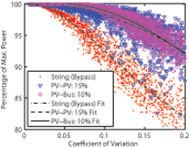Photovoltaic Differential Power Converter Trade-Offs as a Consequence of Panel Variation
Katherine A. Kim with adviser P. T. Krein

Figure 20: Output power performance versus coefficient of variation for series-string with bypass diodes, PV-to-PV at 15% rating, and PV-to-bus at 10% rating.
Photovoltaic elements have inherent variation between cells and panels due to manufacturing tolerance, degradation, and situational differences. This variation increases over the system lifetime and creates MPP current mismatch that reduces output power when PV elements are strung in series. Traditionally, mismatch loss is addressed using cascaded converters. However, our research examines a differential converter architecture that achieves higher efficiency by processing a fraction of the total power. The effect of PV MPP current variance on output power is modeled and compared using a Monte Carlo simulation for the series string architecture and the PV-to-Bus and the PV-to-PV differential power processing (DPP) architectures with converters sized at various power ratings (5%, 10%, and 15%).
Based on these preliminary results, the most appropriate DPP solutions among the tested ratings are the PV-to-bus converter rated at 10% and the PV-to-PV converter rated at 15%. Performance versus the coefficient of variation (CV) between panels for the series-string with bypass diodes, PV-to-PV, and PV-to-bus architectures is shown in Figure 20. The 10% rated PV-to-bus converter shows the best overall performance. The 15% rated PV-to-PV converter shows optimal performance up to about 0.07 CV, which is just under the 25-year estimated CV of 0.76. Both DPP solutions show a significant improvement compared to the string-with-bypass-diodes architecture. Over the expected CV values for a PV system’s 25-year lifetime, both DPP architectures show near optimal performance by sizing DPP converters at 10-20% of the panel ratings. This research is supported by the National Science Foundation through the Graduate Research Fellowship Program, the Grainger Center for Electric Machinery and Electromechanics, and the Advanced Research Projects Agency-Energy (ARPA-E), U.S. Department of Energy, under Award Number DE-AR0000217.
This research is funded by the Grainger Center for Electric Machinery and Electromechanics.